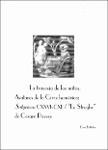Mostrar el registro sencillo del ítem
La travesía de los mitos : Avatares de la Circe homérica: Satyricón CXXVI-CXL / 'Le Streghe' de Cesare Pavese
| dc.contributor.author | Battiston, Dora Delia | |
| dc.date.accessioned | 2020-10-21T00:49:10Z | |
| dc.date.available | 2020-10-21T00:49:10Z | |
| dc.date.issued | 2000-12 | |
| dc.identifier.uri | https://repo.unlpam.edu.ar/handle/unlpam/4501 | |
| dc.description.abstract | La interpretación y representación poética de los mitos, condicionada por las circunstancias de la recepción, manifiesta la funcionalidad que les permite significar y aun denunciar diversas problemáticas y expectativas epocales. Desde la perspectiva comparatista, el personaje de Circe puede ser analizado en sus variantes y alcances simbólicos, a partir de dos instancias. La alusión al siglo I como 'lugar' de transformación del material mitico de la antigüedad remite a los procedimientos de Satyricon CXXVI-CXL que en su retórica de escapismo y ambigüedad parodia la novela erótica griega y propone una Circe cortesana y narcisista, contrafigura de la heroína sentimental. Por otra parte, la consideración de la tensión 'antigüedad/presente' se revela eficaz desde la intertextualidad para abordar el tratamiento del personaje de Circe en Dialoghi con Leuco, donde Pavese, a partir de los universales, la poética del recuerdo y la teoría del lugar mitico, pone en escena los núcleos de su pensamiento y la preocupación existencial por la problemática del destino dialécticamente unida a la búsqueda de la libertad. En el Centro de la historia, Odiseo, el hombre 'arrojado', obligado a ser y a desafiar al destino, se constituye como imagen masculina arquetípica, Circe y Leucotea, Penélope y Calipso lo definen desde la periferia. En esa representación queda implícita la idea del mundo como creación masculina y del hombre como construcción de la mujer. | |
| dc.description.abstract | The interpretation and the poetic representation of myths, conditioned by circurustances of eception, manifest the functionalisrn whicb allows myths lo mean and even to denounce diverse problems and expectations of the epoch. From a cornparative perspective, the character of Circe can be analyzed in its variations and symbolical meanings from two instances. The allusion to the first century as the 'place' of transformation of the mythical material of Antiquity points to the procedures of Satyricon CXXVI-CXL which in itsr hetoric of escapisrn and arnbiguity, parodies the Greek erotic novel and portrays a cowtly and narcissistic Circe as the counterfigure of the sentimental heroine. On the other hand, the consideration of the tension between 'Antiquity/ present' shows to be efficient from the poit of view of intertextuality to approach the analysis of the character of Circe in Dialoghi con Leuco where Pavese, departing from universals, the poetics of memory, and the theory of the mythical place, places on the scene the nucleus of his thought and his existential preoccupation with the problematics of destiny, dialectically united to the search for freedom. In the center of the story, Odysseus, the man 'thrown', forced to be and to defy destiny becomes the archetypal masculine image. Circe and Leucothea, Penelope and Calypso define him from the periphery. In that representation the idea of the world as a masculine creation and of man as womans construction is implicit. | |
| dc.format.extent | p. 45-61 | |
| dc.format.medium | application/pdf | |
| dc.language.iso | spa | |
| dc.rights | Atribución-NoComercial-CompartirIgual 2.5 Argentina (CC BY-NC-SA 2.5 AR) | |
| dc.rights.uri | https://creativecommons.org/licenses/by-nc-sa/2.5/ar/ | |
| dc.source.uri | https://repo.unlpam.edu.ar/handle/unlpam/4494 | |
| dc.title | La travesía de los mitos : Avatares de la Circe homérica: Satyricón CXXVI-CXL / 'Le Streghe' de Cesare Pavese | |
| dc.type | artículo | |
| dc.unlpam.instituciondeorigen | Facultad de Ciencias Humanas | |
| dc.unlpam.seccion | Artículos | |
| dc.unlpam.access | openAccess | |
| dc.unlpam.version | acceptedVersion | |
| dc.unlpam.filiacion | Battiston, Dora Delia. Universidad Nacional de La Pampa. Facultad de Ciencias Humanas; Argentina. | |
| dc.source.revistaunlpam | Circe. 2000; no.5 |
Ficheros en el ítem
Este ítem aparece en la(s) siguiente(s) colección(ones)
-
Circe [467]
Publicación semestral del Instituto de Estudios Clásicos de la Facultad de Ciencias Humanas, UNLPam.











